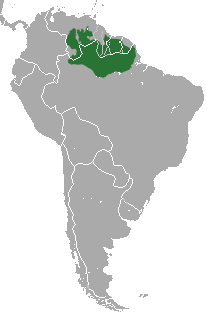Red-backed bearded saki
| Red-backed bearded saki[1] | |
|---|---|

| |
| C. chiropotes in Guyana. | |
| Scientific classification | |
| Domain: | Eukaryota |
| Kingdom: | Animalia |
| Phylum: | Chordata |
| Class: | Mammalia |
| Order: | Primates |
| Suborder: | Haplorhini |
| Infraorder: | Simiiformes |
| Family: | Pitheciidae |
| Genus: | Chiropotes |
| Species: | C. chiropotes
|
| Binomial name | |
| Chiropotes chiropotes (Humboldt, 1811)
| |

| |
| Combined distribution of red-backed bearded saki and brown-backed bearded saki | |
The red-backed bearded saki (Chiropotes chiropotes) is a species of bearded saki, a type of New World monkey, from South America. It is found north of the Amazon River and east of the Branco River in Brazil and the Guianas.[1][3] It is possible the scientific name C. chiropotes belongs to the more westerly brown-backed bearded saki, in which case the correct scientific name for the red-backed bearded saki would be C. sagulatus.[4]
Taxonomy

Previously, this and all other dark-nosed bearded sakis were included as subspecies (or taxonomically insignificant variations) of C. satanas. Based on molecular and morphological evidence, C. utahickae, C. chiropotes and C. sagulatus were split from C. satanas in 2002.[4] C. chiropotes and C. sagulatus were the only members of the genus found north of the Amazon River, with the former west of the Branco River (a major zoogeographic barrier) and the latter east.[4] Supporting evidence for the basic split into four species of dark-nosed bearded sakis was published in 2003, though with one significant difference compared to the earlier study: They treated the population east of the Branco River as C. chiropotes (C. sagulatus in the 2002 study) and west of the river as C. israelita (C. chiropotes in the 2002 study).[3] The taxonomy proposed in 2003 was followed in Mammal Species of the World in 2005.[5] In the study in 2003, a direct comparison of C. israelita and the type specimen of C. chiropotes was not included, but it is assumed that bearded sakis in Venezuela are C. israelita,[6] while C. chiropotes is not present in that country,[1] thereby matching what would be expected from a species pair separated by the Branco River. This is potentially problematic, as the type specimen of C. chiropotes is from Venezuela,[1][7] which could leave israelita as a junior synonym of C. chiropotes, thereby matching the taxonomy proposed in 2002.[4] Due to this confusion, neither C. sagulatus nor C. israelita were recognized by the IUCN in 2008, which maintained all bearded sakis north of the Amazon River as C. chiropotes.[2] However, regardless of the uncertainties over exactly what population the species name chiropotes belongs to, it is clear that there are two distinct populations of bearded sakis north of the Amazon River: A reddish-backed from the Branco River and eastward, and a brown-backed from the Branco River and westward.[3][4]
References
- ^ a b c d Groves, C. P. (2005). Wilson, D. E.; Reeder, D. M. (eds.). Mammal Species of the World: A Taxonomic and Geographic Reference (3rd ed.). Baltimore: Johns Hopkins University Press. p. 146. ISBN 0-801-88221-4. OCLC 62265494.
- ^ a b Veiga, L. M.; Silva Jr., J. S.; Mittermeier, R. A.; Boubli, J.-P. (2008). "Chiropotes chiropotes". The IUCN Red List of Threatened Species. 2008. IUCN: e.T43891A10829879. doi:10.2305/IUCN.UK.2008.RLTS.T43891A10829879.en. Retrieved 12 January 2018.
{{cite journal}}: Unknown parameter|last-author-amp=ignored (|name-list-style=suggested) (help) - ^ a b c Bonvicino, C. R., Boubli, J. P., Otazú, I. B., Almeida, F. C., Nascimento, F. F., Coura, J. R. and Seuánez, H. N. (2003). Morphologic, karyotypic, and molecular evidence of a new form of Chiropotes (primates, pitheciinae). American Journal of Primatology 61(3): 123-133.
- ^ a b c d e Silva Jr., J. S. and Figueiredo, W. M. B. (2002). Revisão sistemática dos cuxiús, gênero Chiropotes Lesson, 1840 (Primates Pithecidae). Livro de Resumos do XO. Congresso da Sociedade Brasileira de Primatologia, Amazônia – A Última Fronteira: 21. Belém, Brazil.
- ^ Groves, C. P. (2005). Wilson, D. E.; Reeder, D. M. (eds.). Mammal Species of the World: A Taxonomic and Geographic Reference (3rd ed.). Baltimore: Johns Hopkins University Press. pp. 146–147. ISBN 0-801-88221-4. OCLC 62265494.
- ^ Groves, C. P. (2005). Wilson, D. E.; Reeder, D. M. (eds.). Mammal Species of the World: A Taxonomic and Geographic Reference (3rd ed.). Baltimore: Johns Hopkins University Press. pp. 146–147. ISBN 0-801-88221-4. OCLC 62265494.
- ^ Cabrera, A. (1961). Catílogo de los mamíferos de America del Sur. Revista del Museo Argentino de Ciencias Naturales Bernardino Rivadavia 4: 309-732.

